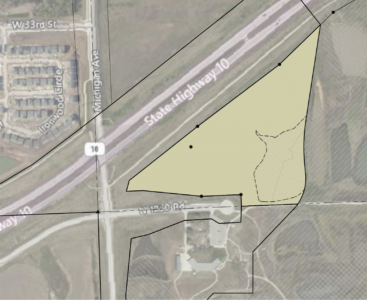After tenant complaint, city condemns converted attic apartment; parent wonders how many rentals are ever inspected to begin with

photo by: Austin Hornbostel/Journal-World
The attic apartment at 1126 Ohio St. was condemned last month following an inspection. It was the first time a City of Lawrence inspector had been inside the unit.
When Kari Taylor’s daughter, Seagan, decided to move into what the family viewed as a “quirky” top-floor apartment of a home at 1126 Ohio St., it was with the caveat that a handful of maintenance issues discussed with the leasing agent would be addressed in short order.
But scattered maintenance issues like leaks and electrical work quickly snowballed into the realization that the unit should never have been a living space in the first place; the apartment was condemned as uninhabitable by the City of Lawrence following an inspection in mid-October.
According to the city’s notice, the unit appears to have been converted from an attic into an apartment at some point without the proper city building permits. It doesn’t meet the required ceiling height specifications, and the emergency means of egress — a window in the space that is supposed to allow occupants to escape in the event of an emergency — was deemed unsafe. It’s positioned too high off the ground and doesn’t open wide enough, and if an occupant does manage to exit through that window they’ll have to navigate a steeply pitched roof to reach an attached ladder on the side of the property and climb to safety.

photo by: Contributed
The attic apartment at 1126 Ohio St. was deemed condemned after a City of Lawrence inspector found that this window, the unit’s means of egress in case of emergencies, didn’t meet city safety codes.
Those issues, however, wouldn’t have been caught in the first place unless Taylor contacted the city. That decision came after some back and forth with Seagan’s property management company, Location Properties, which noted that she’d agreed to conditions in the unit by signing off on the lease. Taylor scheduled an inspection.
“My daughter could tell by the look on (the inspector’s) face that things were grim,” Taylor told the Journal-World. “He said the bathroom is completely unlivable, so it’s not an apartment, but the worst thing he saw was the egress for the fire (exit).”

photo by: Contributed
A view out the window of the attic apartment at 1126 Ohio St., which served as the unit’s emergency means of egress in case of an emergency, shows that getting to a ladder to safety would involve trekking across a steep roof first.
Since Oct. 26, Location Properties owner Bryan Hedges told the Journal-World the unit has been removed from the list of the company’s available rentals and locked off so no other tenants can use it. The company also doesn’t plan on renting out the unit again unless the property owners hire a third-party contractor to follow the city’s recommendations and rebuild it to current city code.
“The preliminary legal advice we have obtained indicates that the process we followed was correct, which was to end the lease when we received the notification from the city that this particular unit doesn’t meet current code, refund the deposit in full, and refund the prorated rent to the day the city said this unit needed to be vacated,” Hedges said in an email response to the Journal-World. “We have followed this recommended process.”
Hedges said it’s an ongoing legal matter, specifically because Taylor is also seeking a refund for the rent Seagan paid while living in the unit from August to mid-October, which Hedges describes as “effectively giving her free rent for nearly three months.” Taylor told the Journal-World that in her eyes, the lease was invalid because the unit wasn’t up to code in the first place.
Hedges said the company didn’t have any concerns about the unit, which he said “appeared in good condition” at the time Seagan moved in. Save for some maintenance requests Hedges said the company handled like it would for any unit, Location Properties had no indication of the unit not meeting today’s code until receiving notice from the city.

photo by: Contributed
A view of the bathroom area of the attic apartment at 1126 Ohio St. shows the low, sloped ceilings that a City of Lawrence deemed another violation of safety codes.
Another representative with Location Properties told Taylor in an earlier email that the code violations came as a “shock,” as the unit was being used as an apartment long before the company began managing it, and a message included with an account statement sent to Seagan after she moved out notes that the unit has been occupied by five different tenants since 2014.
It also didn’t help that the previous property owners have died in recent years, Hedges said, and property ownership is now in an LLC with surviving family members as Location Properties’ contact. Because the current owners haven’t remodeled the property, a city building permit hasn’t been necessary — and thus not applied for — while Location Properties has been managing the property. The company has only been required to apply for a rental property license.
Representatives with Location Properties declined to connect the Journal-World with the property owners for comment. Hedges said the company doesn’t give out such information in the interest of confidentiality. A search of Douglas County property records lists four owners for the property.
•••
About a year ago, the Lawrence City Commission approved an ordinance that resulted in a number of changes to the city’s rental inspection program. The structure of that program since its inception in 2014 had resulted in less than 1% of rental properties being inspected annually. That’s because the city had to inspect only 10% of a landlord’s portfolio of units — not to exceed 15 units total — once every three years, or even less frequently thanks to a six-year exemption from inspections if fewer than five violations were found per unit.
Based on data in the city’s annual rental license report for 2019, that worked out to just 206 first-time inspections out of the 21,174 rental units licensed by the city.
The new ordinance took effect at the start of 2022, and it included increasing the sampling size of each landlord’s units from 10% to 20%, not to exceed 25 of a landlord’s total units. Another change results in a broadened definition of what counts as a violation, making inspections generally less permissive of infractions.
The ordinance also changed the incentive program that exempts all of a landlord’s properties from inspections for six years. The new ordinance changed the maximum number of violations a property owner can have to qualify from five to three, and it added a requirement that an additional 20% of a landlord’s units be inspected if more than seven violations per unit are discovered.
But for now, it’s hard to gauge exactly how much those changes have moved the needle when it comes to ensuring units like this one don’t slip through the cracks. That’s because the 2019 rental license report is still the most recent one available. Rental inspections, like much else during the pandemic, ground to a complete halt in March of 2020 and didn’t start up again until the second half of 2021.
Brian Jimenez, code official and assistant director of building safety for the City of Lawrence, told the Journal-World that city inspectors had actually been inside 1126 Ohio St. before — back in 2017 — but had never inspected the third-floor unit. When an inspector did pay the attic unit a visit for the first time last month, it didn’t take long to notice issues.
“… He immediately recognized, ‘Wow, we have a big issue here,’ because there’s no way this structure can meet minimum ceiling heights,” Jimenez said. “So that’s where we landed on this one.”
The reason this unit may never have been inspected is because the city makes it a goal to spread inspections out as much as possible, Jimenez said. For a property owner who owns four properties and needs eight units inspected to meet the percentage requirement outlined in the city ordinance, for example, the city will shoot for inspecting two units per property. Vacant units also tend to take priority, he said, to make it easier on the owner and prevent disturbing tenants.
The rate of city inspections performed in response to tenant complaints ebbs and flows, but Jimenez said such complaints generally come in at least weekly, sometimes multiple complaints per week. How often those inspections result in an outright condemnation, however, is much more rare. Jimenez said he thinks the city issued just four condemnation notices last year.
“It’s got to be a really substantial life safety code violation for us to deem a property uninhabitable,” Jimenez said.
But the volume of rental units in the city, which Jimenez said increases by the year, makes it impossible for the city to inspect more. One thing that helps is that new builds and major remodels that are 10 years old or newer are exempt from the inspection pool, since they’ll have already passed a building inspection after construction was complete.
•••
Jimenez said the city always encourages tenants to try to identify and remediate problems with their property manager or landlord first. Though he said city inspectors are always glad to come take a look, to get to that point likely means the relationship between those two parties has become pretty strained.
“We go into complaint inspections unbiased,” Jimenez added. “We are all, obviously, looking out for code compliance and life safety issues to protect tenants, so that’s important to know. That’s what the program is really intended for, on a limited 20% sampling, is to try to work and bring properties into compliance with the minimum standards of what the city code regulates.”
For Taylor, the situation’s a matter of safety that she said she worries about for other community members. She pointed to a series of incidents that happened in the Oread neighborhood, including a person falling from a roof area that had no railing, nearly two decades ago that were a factor in the initial push from community members to increase the rate of rental inspections in Lawrence.
“It makes me wonder how many units in Lawrence kids live in that aren’t (inspected),” Taylor said. “… These are concrete code requirements. You just have to go in there with a measuring tape and you can tell it’s not code compliant. Now we know that the units in Lawrence, you just can’t assume that they’ve ever been inspected.”








COMMENTS